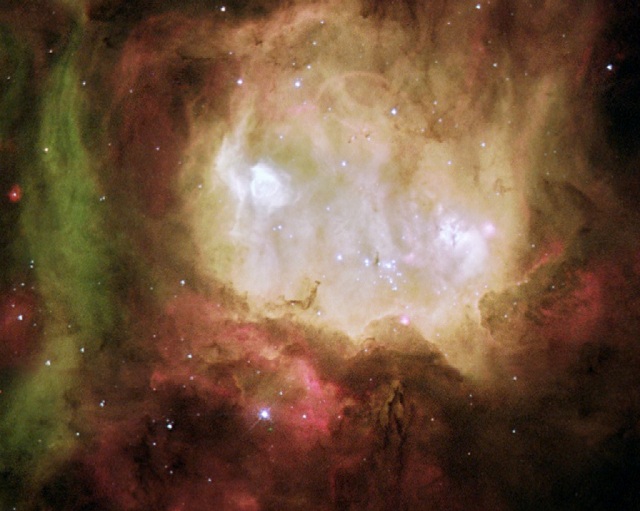By Annelies Rhemrev
October 11, 2012
The Ghost Head Nebula, an emission nebula in the LMC
Image Credit: NASA/ESA & Mohammad Heydari-Malayeri (Observatoire de Paris, France)
Click here for a larger image
The Ghost Head Nebula (NGC 2080) is an emission nebula and star-forming region of some 55 light-years across located about 168,000 light-years away in the southern constellation Dorado. The Ghost Head is one of a chain of star-forming regions lying south of the 30 Doradus (Tarantula) nebula in the Large Magellanic Cloud (LMC, a satellite galaxy to our Milky Way galaxy).
Two bright regions, called the “Eyes of the Ghost”, named A1 (left) and A2 (right), are very hot, glowing ‘blobs’ of hydrogen and oxygen. The bubble in A1 is produced by the hot, intense radiation and powerful stellar wind from a single young, massive star. A2 has a more complex appearance due to the presence of more dust, and because it contains several young stars in a newly formed cluster, still obscured by their originating dust cloud The massive stars in A1 and A2 must have formed within the last 10,000 years since their natal gas shrouds are not yet disrupted by the powerful radiation of the newly born stars. These stars together have begun to create a bubble in the nebula with their outpourings of material, called stellar wind.
The presence of stars also greatly influences the color of the nebula. The light from the nebula captured in this image is emitted by two elements, hydrogen and oxygen. Astronomers use the separated colors produced by these elements to investigate star-forming processes in the Ghost Head Nebula. The colors explain much about the nature of such nebulae.
The red and the blue light are from regions of hydrogen gas heated by nearby stars. The green light on the left comes from glowing oxygen. The energy to illuminate the green light is supplied by a powerful stellar wind (a stream of high-speed particles) coming from a massive star just outside the image. The white region in the center is a combination of all three emissions and indicates a core of hot, massive stars in this star-formation region. The intense emission from these stars has carved a bowl-shaped cavity in the surrounding gas.
This image was taken by the NASA/ESA Hubble Space Telescope on March 28, 2000.
Read more on Anne’s Astronomy News



